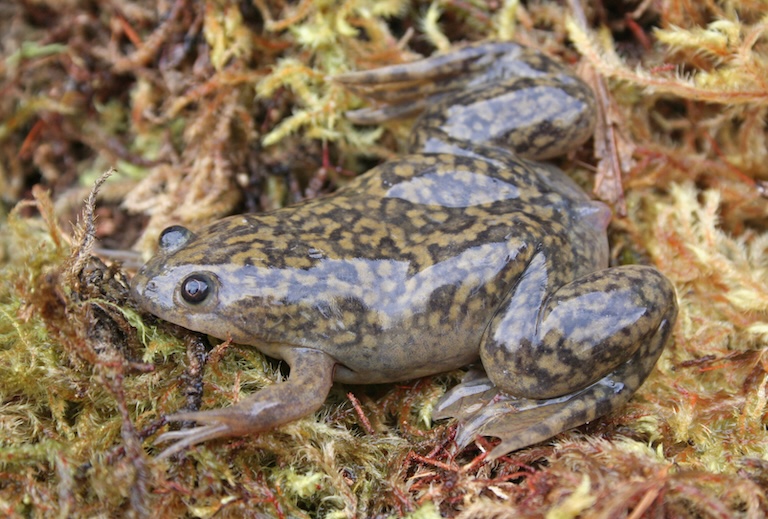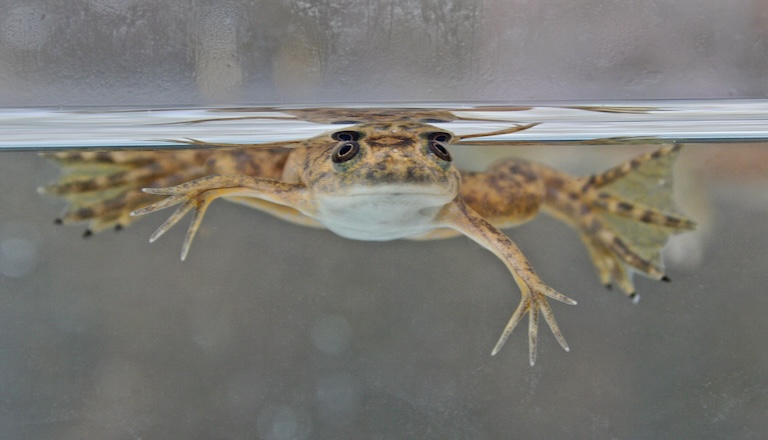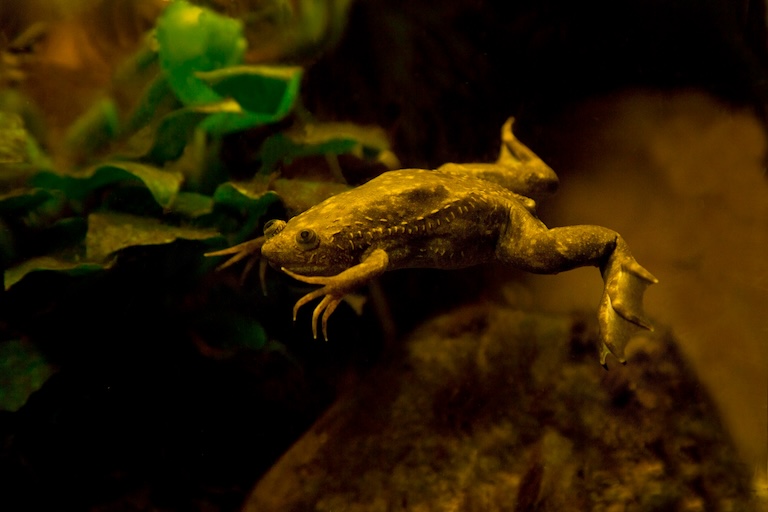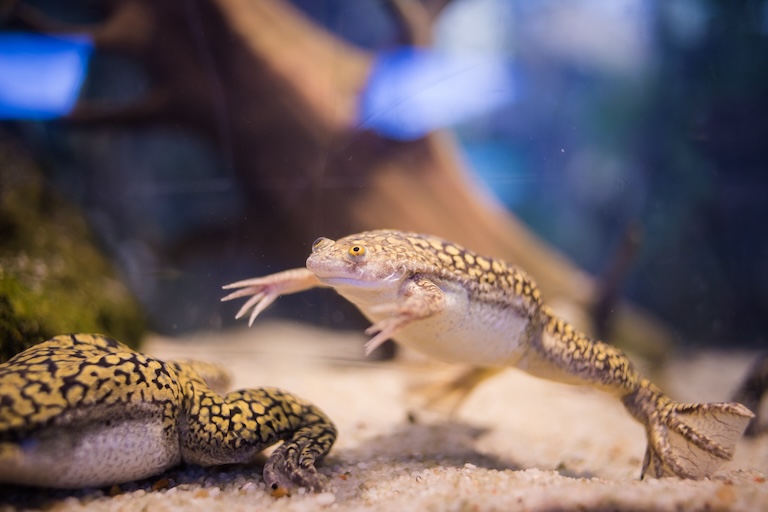Xenopus Profile
There’s no getting around it: we are fish. Land-dwelling, beer swilling, somewhat hairy fish, perhaps, but fish nonetheless. And as fish, we have transitioned quite a few significant times from our marine cousins into the scaleless, greasy wonders we are now.
One of the most important transitions occurred around 360 million years ago, when we were amphibians, and decided we could go one step further and protect our eggs in hard shells so as not to have to keep getting wet when giving birth. And so, on the path to becoming mammals, we became reptiles. But we left behind a common ancestor with a frog line that’s still around today. One that didn’t leave the water, and didn’t choose to get hairy.
One that has since become one of the most significant genera to the study of vertebrate evolution: the clawed frogs, Xenopus.

Xenopus Facts Overview
| Habitat: | Varied: rainforest to semi-desert and from lowland swamps to alpine lakes |
| Location: | Sub-Saharan Africa |
| Lifespan: | More than 30 years in some speices |
| Size: | From 5cm to 20 cm (2 to 8 inches) depending on the species |
| Weight: | Up top 200g |
| Colour: | Varied, usually green or brown |
| Diet: | Mostly invertebrates, scavengers and generalist predators |
| Predators: | Mostly birds |
| Top Speed: | Slow |
| No. of Species: | 20+ |
| Conservation Status: | Most are Least Concern, some Endangered or Vulnerable |
Xenopus frogs have special claws on their feet for both defence and attack, and function as fully aquatic predators in Africa. But to us humans, they function as some of the most significant biological organisms to the discipline of biological study.
These weird frogs have no tongue, live almost entirely underwater, and their females are four times the size of the males.
So like us.
Interesting Xenopus Facts
1. They have strange feet
Xenopus is a genus in the quaintly-named Pipidae family of frogs. These are a group of very primitive animals, thought to be a bit of a transitional animal between aquatic and land vertebrates.
They’re found in South America and Africa, though the Xenopus group is entirely African. Their feet are completely webbed and they are flattened, giving them a weird appearance, even for frogs.
Xenopus frogs are named after their weird feet, with the genus name translating almost exactly to “weird foot”. More commonly, they’re called clawed frogs, on account of many species having claws on their back feet.
These feet aren’t great for hopping, or indeed much terrestrial locomotion at all, and instead are more adapted to live in the water1.

2. They have no tongue
The Pipidae family re also called the tongueless frogs, and this is for the exact reason you’d expect.
Not only do Xenopus frogs have no tongue, but they also have a small tentacle situated under each eye. So, these are truly strange animals, but it gets weirder.
These frogs have a lateral line. This is a row of sensory cells along the flanks of their bodies. They’re set up to detect pressure and vibration in the water, and are almost exclusively found in fish. Tadpoles have them, but typically in frogs these are lost as they morph into adults.
And here we begin to see clues to what makes this genus so special2.
3. They’re fully aquatic
Xenopus species, unlike the vast majority of frogs – and the definition of the word amphibian – are pretty much fully aquatic. This means they don’t exhibit the terrestrial life stages that lends the class their name, and instead prefer to stay in the water forever.
They can cross land, and they do breathe using their lungs as adults, but aside from brief and clumsy excursions across the ground to get to another pool, these are aquatic animals. This is where they eat, sleep, and breed. And when it comes to breeding, the females are easy to spot.

4. They’re very sexually dimorphic
Sexual dimorphism is very common. Humans exhibit it in both size and shape, with female humans generally being a bit smaller than males and having a different selection of dangly bits than the males.
In mammals, this is most extreme in the Mandrill. The male mandrill is the largest monkey, and around 3.5 times the size of the relatively tiny female.
In amphibians, this is flipped, with females being much larger in 90% of species. The clawed frogs toe the line here, and to a remarkable degree.
A large female Xenopus laevis might surpass 200g, while her male counterpart will be just over 50g. This is a snu-snu factor of around 4x time the size; even more than the mandril, and is pretty remarkable, though for reference, in the oceans, the blanket octopus can have females that are 40,000 times the mass of the males!
5. They have a lot of chromosomes
Ploidy is an awkward word that was reverse-engineered from the Greek words for one-fold and two-fold. In genetics, it refers to the sets of chromosomes found in the nucleus of an animal’s cells.
Humans have paired chromosomes, which makes us diploid, but many invertebrates like ants, are haploid, and carry around theirs as single bundles. Vertebrates don’t exhibit haploidy as it would break the way sex works and nobody wants that, but chromosomes can also go the other way, into what’s called polyploidy.
The Xenopus genus has up to 12 sets of chromosomes, and this is quite a lot, but still well below the record for vertebrates. Salmon, for example, can have up to 400.
Having more chromosome pairs allows for more protection against mutations, and it also aids in asexual reproduction. And this genus of frogs has generated a lot of attention for both of these reasons.
6. They’re famous
This genus is one of the most widely cited vertebrate animal in the scientific literature. For a long time, most of this data came from a single species, but in the past few decades, the genus became populated with up to 20 or more species, many of which are now highly significant to biological research.
In 2012, Sir John Gurdon was awarded the Nobel Prize in Physiology or Medicine for figuring out that you can take a nucleus from the skin of one of these frogs, inject it into that same frog’s egg, and you’ll end up with a clone of the adult3.
This rocked the public consciousness for a while, and culminated in an infamous sheep called Dolly who was the first such clone the public were ever let in on. She wasn’t a healthy clone, though, and as put down after suffering from lung disorders at around 6 years of age.
Still, it set the groundwork for the future race of Supersoldier mutants the Americans are no doubt working on.
And this isn’t all these frogs should be held responsible for!

7. They’re a model organism
We are, for all intents and purposes, fish. Sarcopterygians, to be specific, the so-called lobe-finned fishes. Today, the only marine examples of this ancient order are the coelacanths and the lungfish, but on land, we really took over.
All terrestrial vertebrates descend from a fish much like the lungfish, whose rotating shoulder girdle and modified lung allowed it an advantage when dragging its mucous-covered arse out of the water, over 400 million years ago.
Today, our mucous covered arses are generally independent of water bodies, other than the daily need to drink, but between those fishes and us, there were transitional forms, including the reptilian protomammals and their amphibian ancestors.
So, amphibians represent a transitional stage between the marine fish and the sofa-dwelling, dry land fish. And the Xenopus line is one of the most primitive of all, giving us one of the clearest pictures of what these amphibian ancestors would have been like.
They’re also very easy to study!
Having large and external embryos, we can clearly witness the development of their young, and compare that to the development of our own embryos to get a clue as to where we diverged.
From their embryos, scientists have discovered how our body plan is determined in the womb, how cells talk to one another, and how hormones remodel our bodies.
Xenopus Fact-File Summary
Scientific Classification
| Kingdom: | Animalia |
| Phylum: | Chordata |
| Class: | Amphibia |
| Order: | Anura |
| Family: | Pipidae |
| Genus: | Xenopus |
| Species Name: | 20+ species |
Fact Sources & References
- Ishibashi, et, al (2017), “Xenopus as a Model Organism for Biomedical Research”, Science Methods for Clinical Researchers.
- Daudin (1802), “Nonindigenous Aquatic Species”, USGS science for changing world.
- , “Why do we use xenopus frogs?”, Research at Cambridge.
